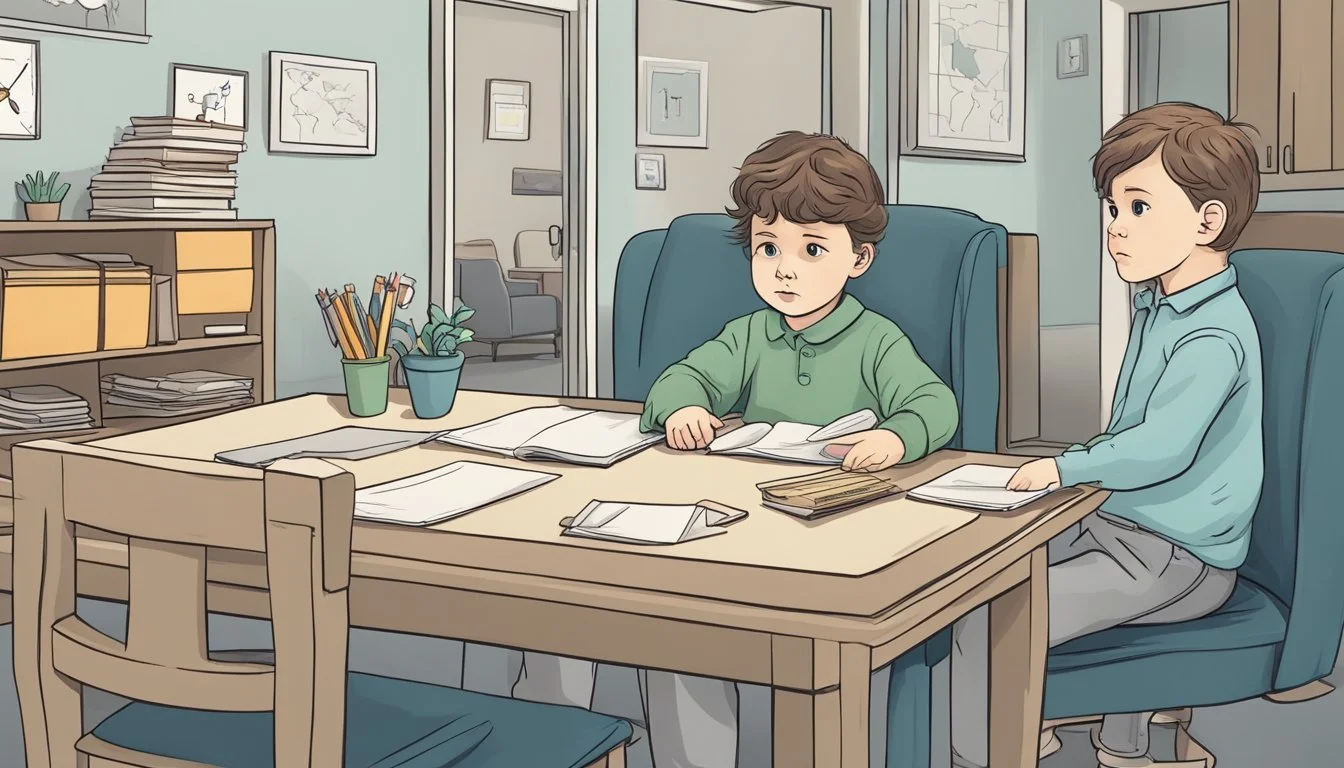Can a 4-Year-Old Be a Psychopath? Understanding Early Behavioral Concerns
Identifying psychopathic traits in young children is a complex and sensitive topic that concerns many parents and professionals. While the term "psychopath" is not typically applied to 4-year-olds, certain behaviors may raise red flags. Research suggests that early signs of psychopathy can be observed in children as young as 2 years old, including a lack of empathy, aggression, and difficulty forming emotional bonds.
These traits often manifest differently in young children compared to adults. A 4-year-old exhibiting potential psychopathic tendencies might show a persistent lack of concern for others' feelings, engage in cruel behavior towards animals or peers, or display frequent and severe temper tantrums that go beyond typical developmental norms.
It's crucial to note that many children may exhibit some of these behaviors without developing psychopathy. Professional evaluation is essential for accurate assessment and appropriate intervention. Early identification and support can significantly impact a child's developmental trajectory and future outcomes.
Understanding Childhood Psychopathy
Childhood psychopathy involves a distinct set of behavioral and emotional traits that can manifest in young children. These traits include a lack of empathy, callousness, and manipulative tendencies. Brain differences may play a role in the development of psychopathic characteristics.
Defining Psychopathy in Children
Psychopathy in children refers to a pattern of behaviors and traits that resemble adult psychopathy. These include a lack of empathy, shallow emotions, and indifference to others' distress. Signs can appear as early as age 2, according to research from the University of Michigan.
Children with psychopathic traits often show little remorse or guilt for their actions. They may manipulate others for personal gain and display aggressive behaviors. It's important to note that not all children who exhibit some of these traits will develop psychopathy.
Diagnosis is complex and requires careful evaluation by mental health professionals. Conduct disorder is often associated with childhood psychopathy, but not all children with conduct disorder have psychopathic traits.
Psychopathic Traits and Behavior
Key psychopathic traits in children include:
Lack of empathy
Callous-unemotional behavior
Aggression
Manipulative tendencies
Shallow emotions
Impulsivity
Children with these traits may show cruelty to animals or other children. They often struggle to form genuine connections with peers or family members. Their behavior can be unpredictable and sometimes violent.
Some children display uncontrollable anger when faced with perceived slights. They may lie frequently and show little concern for the consequences of their actions. These behaviors can cause significant disruption in school and home environments.
Brain Science Behind Psychopathy
Brain imaging studies have revealed differences in the brains of individuals with psychopathic traits. The amygdala, a key part of the limbic system involved in processing emotions, often shows reduced activity in psychopaths.
This decreased amygdala function may contribute to:
Reduced fear response
Difficulty recognizing others' distress
Impaired emotional learning
Other brain areas involved in decision-making and impulse control, such as the prefrontal cortex, may also function differently in individuals with psychopathic traits. These neurological differences can affect a child's ability to process social cues and develop empathy.
Researchers are still working to fully understand the complex interplay between genetics, environment, and brain development in childhood psychopathy. Early intervention strategies often focus on addressing these brain-based differences through targeted therapies and environmental modifications.
Genetic and Environmental Factors
Psychopathy in young children stems from a complex interplay of genetic predispositions and environmental influences. Both nature and nurture play crucial roles in shaping a child's personality and behavior patterns.
Role of Genetics in Psychopathy
Genetic factors contribute significantly to the development of psychopathic traits in children. Studies on twins and adopted children have revealed a strong hereditary component. Specific genes linked to callous-unemotional behaviors and antisocial tendencies have been identified.
Research indicates that genetic influences account for 40-60% of the variance in psychopathic traits. This genetic predisposition can manifest as early as age 4.
However, genes alone do not determine a child's fate. Environmental factors play a critical role in either amplifying or mitigating genetic risks.
Influence of Environmental Factors
Environmental factors can profoundly impact a child's psychological development. Parenting styles, family dynamics, and socioeconomic conditions all play crucial roles.
Inconsistent discipline, lack of warmth, and exposure to violence can exacerbate psychopathic tendencies. Conversely, positive parenting practices and stable home environments can help mitigate genetic risks.
Early intervention programs focusing on parent-child interactions have shown promise in reducing psychopathic behaviors. These interventions aim to foster empathy, emotional regulation, and prosocial skills in at-risk children.
Neglect, Abuse, and Development
Severe neglect and abuse during early childhood can significantly increase the risk of developing psychopathic traits. Traumatic experiences can alter brain development and impair emotional processing.
Children who experience chronic neglect may struggle to form secure attachments and develop empathy. Physical and sexual abuse can lead to emotional detachment and aggressive behaviors.
However, not all abused children develop psychopathy. Protective factors such as resilience and supportive relationships can buffer against adverse experiences.
Early identification and intervention are crucial for children exposed to neglect and abuse. Trauma-informed care and therapy can help mitigate the long-term impacts on personality development.
Behavioral Characteristics and Diagnostics
Identifying psychopathic traits in young children involves observing specific behavioral patterns and emotional responses. Early detection can be crucial for intervention and support.
Identifying Callous and Unemotional Traits
Callous and unemotional (CU) traits are key indicators of potential psychopathy in children. These traits include:
Lack of empathy or concern for others' feelings
Limited emotional expression
Absence of guilt after misbehaving
Indifference to punishment
Children with CU traits may show little reaction to others' distress or pain. They might harm animals or peers without remorse. These behaviors can be observed in children as young as 2 years old.
Diagnosing Psychopathy in Early Childhood
Diagnosing psychopathy in young children is complex and controversial. Mental health professionals use various tools and criteria:
Observation of behavior over time
Interviews with parents and caregivers
Standardized assessments
The Diagnostic and Statistical Manual of Mental Disorders (DSM-5) doesn't include a specific diagnosis for childhood psychopathy. Instead, clinicians may look for signs of conduct disorder with callous-unemotional traits.
Early diagnosis is challenging due to rapid developmental changes in young children. Professionals must differentiate between typical developmental stages and persistent problematic behaviors.
Warning Signs and Red Flags
Several warning signs may indicate potential psychopathic traits in young children:
Persistent lying and manipulation
Aggressive behavior towards people or animals
Lack of emotional attachment to caregivers
Absence of fear in dangerous situations
Cruelty without remorse
Parents should be aware of these red flags:
Consistent disregard for rules and boundaries
Inability to form meaningful relationships
Extreme reactions to minor frustrations
Early intervention is crucial when these signs are present. Professional evaluation can help determine appropriate support and treatment options for the child and family.
Emotional and Cognitive Aspects
Four-year-olds with psychopathic tendencies display distinct patterns in their emotional and cognitive functioning. These patterns manifest in their interactions, decision-making, and responses to various stimuli.
Lack of Empathy and Remorse
Children with psychopathic traits often struggle to understand or share the feelings of others. They may hurt peers without showing remorse or concern for the consequences. This lack of empathy can lead to seemingly cruel behaviors.
These children might take toys from others without considering how it makes them feel. They may also lie or break rules without showing guilt. Their indifference to others' emotions can be unsettling for parents and caregivers.
It's important to note that empathy develops gradually in young children. However, those with psychopathic tendencies show a more pronounced and persistent lack of empathy.
Understanding Cognitive and Affective Responses
Cognitive empathy, the ability to recognize others' emotions, may be present in these children. However, they often lack affective empathy, the capacity to feel others' emotions.
This disconnect can result in manipulative behaviors. A child might understand that a peer is sad but use this knowledge for personal gain rather than to offer comfort.
Their cognitive processes may differ from typical development. They might show advanced reasoning in some areas while lagging in moral understanding.
These children may struggle with cause-and-effect relationships, particularly in social contexts. They might repeat harmful behaviors despite negative outcomes.
Emotional Dysregulation and Psychopathy
Emotional dysregulation is a key feature in children with psychopathic traits. They may experience intense mood swings or seem emotionally flat.
These children often have difficulty managing anger and frustration. Tantrums might be more severe or frequent than in their peers. They may resort to aggressive behaviors when upset.
Their emotional responses can seem out of proportion to situations. A minor setback might trigger an extreme reaction, while major events elicit little response.
It's crucial to recognize that emotional regulation skills are still developing at this age. Professional evaluation is necessary to distinguish between typical developmental challenges and more serious concerns.
Social Dynamics and Consequences
Children exhibiting psychopathic traits often struggle with social interactions and face negative outcomes. These challenges can manifest in various ways, impacting relationships with peers, treatment of animals, and potential future behaviors.
Relationship Between Psychopathy and Bullying
Children with psychopathic tendencies are more likely to engage in bullying behaviors. They may lack empathy for their victims and derive satisfaction from exerting power over others. These children often target vulnerable peers, using manipulation and aggression to maintain dominance.
Bullying tactics can include physical violence, verbal abuse, and social exclusion. The child may show little remorse when confronted about their actions, making intervention challenging.
Peers may fear or avoid the child, leading to social isolation. This isolation can reinforce negative behaviors and hinder the development of prosocial skills.
Cruelty to Animals and Other Forms of Aggression
Animal cruelty is a concerning behavior associated with childhood psychopathy. These children may harm pets or wildlife without apparent guilt or understanding of the pain they cause.
This cruelty can extend to other forms of aggression:
Physical attacks on siblings or classmates
Destruction of property
Verbal threats and intimidation
Early intervention is crucial to address these behaviors and prevent escalation. Professional help may be necessary to develop empathy and impulse control.
Potential Paths to Antisocial and Criminal Behavior
Without proper intervention, children with psychopathic traits face an increased risk of developing antisocial personality disorder in adulthood. This can lead to a pattern of disregard for social norms and the rights of others.
Risk factors for criminal behavior include:
Persistent aggression
Lack of empathy
Poor impulse control
Early engagement in delinquent acts
Early identification and targeted interventions are key to altering these potential outcomes. Therapy, social skills training, and family support can help redirect the child's development towards more positive behaviors.
Addressing underlying factors, such as childhood trauma or neglect, may also play a role in preventing the progression to antisocial and criminal behaviors.
Assessment and Measurement Tools
Evaluating psychopathic traits in young children requires specialized instruments designed for their developmental stage. These tools help identify potential concerns and guide intervention strategies.
Youth Psychopathic Traits Inventory (YPI)
The Youth Psychopathic Traits Inventory (YPI) is a self-report measure for assessing psychopathic traits in adolescents. It consists of 50 items divided into 10 subscales, covering three dimensions: interpersonal, affective, and behavioral. The YPI focuses on personality traits rather than antisocial behaviors.
This tool is designed to be less susceptible to social desirability bias. It uses indirect questions and presents psychopathic traits as abilities or positive characteristics. The YPI has shown good internal consistency and test-retest reliability.
Researchers use the YPI to study the development of psychopathic traits in youth populations. It helps identify at-risk individuals and informs early intervention strategies.
Hare's Psychopathy Checklist for Children
Hare's Psychopathy Checklist for Children is an adaptation of the adult version for use with younger populations. It assesses interpersonal, affective, and behavioral features associated with psychopathy.
This clinician-rated instrument requires extensive training to administer. It combines a semi-structured interview with collateral information from various sources, including parents, teachers, and official records.
The checklist evaluates traits such as callousness, lack of empathy, and manipulative behavior. It also considers conduct problems and antisocial tendencies.
Scores from this assessment can inform treatment planning and risk management strategies. However, its use in young children remains controversial due to concerns about labeling and the stability of psychopathic traits at early ages.
Treatment and Intervention Strategies
Early intervention is crucial for children exhibiting psychopathic traits. Comprehensive approaches aim to modify behavior, address underlying issues, and provide support for both the child and family.
Behavioral and Psychosocial Interventions
Behavioral therapies focus on reinforcing positive behaviors while discouraging negative ones. Rewards-based systems can be effective, as children with psychopathic traits often respond better to rewards than punishment.
Parent training programs teach caregivers strategies to manage challenging behaviors and promote empathy. These interventions typically start as early as age 3-4, when traits first become noticeable.
Social skills training helps children develop appropriate peer interactions and emotional recognition. Cognitive-behavioral therapy (CBT) can address thought patterns contributing to antisocial behaviors.
The Role of Medication and Therapy
While no medications specifically treat psychopathy, some may help manage associated symptoms. Antipsychotics or mood stabilizers might be prescribed for aggression or impulsivity.
Individual therapy focuses on building emotional awareness and moral reasoning. Family therapy involves parents and siblings to create a supportive home environment.
Play therapy can be beneficial for younger children, allowing them to express emotions in a safe setting. Art or music therapy may help those who struggle with verbal expression.
Residential Treatment Programs
Severe cases may require intensive residential treatment. These programs provide 24/7 structured environments with constant supervision and support.
Staff members are trained to handle challenging behaviors and implement consistent behavioral strategies. Programs typically last several months to a year.
Daily schedules include individual and group therapy sessions, academic instruction, and recreational activities. Family involvement is encouraged through regular visits and therapy sessions.
Aftercare planning is crucial for a smooth transition back home. This may include outpatient therapy, school support, and ongoing family interventions to maintain progress.
Parental Guidance and Support
Raising a child with psychopathic traits requires specialized strategies and support. Parents need to establish clear boundaries, manage challenging behaviors, and seek appropriate resources.
Creating Appropriate Boundaries and Expectations
Setting consistent boundaries is crucial for children with psychopathic tendencies. Establish clear rules and consequences for behavior. Use a firm, calm tone when enforcing limits. Avoid emotional reactions, as these may reinforce negative behaviors.
Create a structured daily routine to provide stability. Clearly communicate expectations for tasks and interactions. Praise positive behaviors to encourage their repetition. Implement a reward system for meeting expectations.
Use time-out techniques effectively for rule violations. Remove privileges as a consequence for serious infractions. Be consistent in applying consequences to prevent manipulation.
Strategies for Managing Callous-Unemotional Traits
Children with callous-unemotional (CU) traits often struggle with empathy and emotional connections. Focus on teaching emotional recognition and appropriate responses. Use visual aids like emotion charts to help identify feelings.
Practice perspective-taking exercises to build empathy skills. Encourage the child to consider others' viewpoints in various situations. Role-play scenarios to demonstrate appropriate emotional responses.
Implement reward-oriented behavior modification techniques. Positive reinforcement is often more effective than punishment for children with CU traits. Celebrate small improvements in empathetic behavior.
Engage in activities that promote bonding and attachment. Shared experiences can help strengthen emotional connections over time.
Support Resources for Parents
Parenting a child with psychopathic traits can be emotionally taxing. Seek professional help from child psychologists or psychiatrists specializing in conduct disorders. Participate in parent training programs designed for managing challenging behaviors.
Join support groups for parents facing similar challenges. These groups provide a safe space to share experiences and coping strategies. Online forums and local meet-ups can offer valuable peer support.
Consider family therapy to address relationship dynamics and improve communication. Therapy can help siblings cope with the unique family situation.
Explore educational resources on psychopathy in children. Books, websites, and workshops can provide valuable insights and management techniques. Stay informed about current research and treatment options.
Future Considerations and Research
Research on psychopathic traits in young children remains an evolving field. Ongoing studies aim to refine assessment methods and explore potential interventions. Public perception and societal impacts are also key areas of focus.
Ongoing Studies and Theoretical Developments
Researchers are investigating early indicators of psychopathic traits in children as young as 2 years old. Longitudinal studies track the stability of these traits over time. Neuroimaging techniques are being used to examine brain structure and function in children exhibiting psychopathic tendencies.
Some studies focus on the role of reward systems in shaping behavior. Others explore the interplay between genetic predisposition and environmental factors. Improved assessment tools are being developed to differentiate between normal childhood behavior and concerning patterns.
Mental health professionals are working to create age-appropriate interventions. These aim to address impulsiveness, thrill-seeking, and lack of empathy in young children.
Societal Impact and Public Perception
The concept of childhood psychopathy raises ethical concerns and public debate. Media portrayals often sensationalize the issue, potentially stigmatizing children with behavioral problems.
Education efforts are underway to inform parents, teachers, and healthcare providers about early warning signs. Emphasis is placed on seeking professional help rather than labeling children as "psychopaths."
Policy makers are considering the implications for child welfare and juvenile justice systems. Balancing public safety with the need for compassionate treatment remains a challenge.
Ethical guidelines for research and intervention with young children are being refined. Long-term studies will be crucial in understanding the effectiveness of early interventions.










